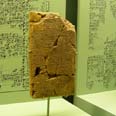
Rare 4,000 year old cuneiform tablet
Jerusalem conference to focus on lunar calendar
Bible Lands Museum to host leading international scholars investigating place of calendar reckoning in human society and culture
The Bible Lands Museum in Jerusalem will host an international conference titled "Living the Lunar Calendar: Time, Text and Tradition" on January 30 through February 1.
Leading international scholars will present three days of lectures, sessions and events at the Bible Lands Museum, including a fully-guided tour to Qumran, where the Dead Sea Scrolls were hidden for centuries.
A partial list of speakers includes Prof. Lawrence H. Schiffman, New York University; Prof. Sacha Stern, University College London; Prof. Wayne Horowitz, Hebrew University Jerusalem; Prof. John Steel, Brown University USA; Prof. Stanislaw Iwaniszewski, National Institute of Anthropology and History, Mexico; and Dr. Jonathan Ben-Dov, University of Haifa.
The “Living the Lunar Calendar” conference — held under the full moon of the Tu B'Shvat Jewish festival (new Year for trees)— will investigate the place of calendar reckoning in human society and culture.
Focusing on the moon as a marker of the passage of time, the conference will address a wide variety of issues regarding the application of astronomical and calendrical rules to everyday life, and beyond to the shaping of cultural identity.
The conference will begin on Saturday night with introduction lectures to Astronomy, the moon’s movements and its importance in determining the time. The second day of the conference will be devoted to the history of the Jewish calendar: with sessions devoted to Mesopotamia and to the use of the traditional Jewish lunar calendar.
The day will conclude with a night tour to Qumran, the site serves as a living testimony to the issues examined in the conference. The third day will be devoted to the Hebrew calendar with respect to other cultures: The Classical World, the Christian World, America and the Far East.
The Bible Lands Museum Jerusalem collection includes an extremely important rare cuneiform tablet is prominently displayed in the heart of the Museum's Gallery of the Patriarchs.
This large clay tablet is written in cuneiform on two sides and careful study and decipherment has revealed text that sheds light on the roots of the Hebrew calendar whose origins stem from Ancient Babylon. It describes the religious practices of the Babylonians from the time of Abraham.
The rare tablet takes the visitors to the ancient month Shabatu, 4,000 years ago. It is an example of a text recording the daily routine followed in the temples of the capital city of Larsa, which neighbored Ur in ancient Mesopotamia. In over six hundred and thirty lines, the tablet registers the rites performed in the temples during the month of Shabatu. This month is identical to the Hebrew month of Shvat and they are both the eleventh month of the year.










